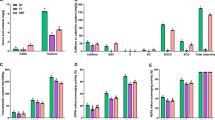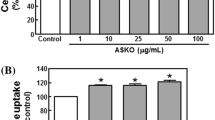Abstract
Green tea extract (GTE) is regarded to be effective against obesity and type 2 diabetes, but definitive evidences have not been proven. Based on the assumption that the gallated catechins (GCs) in GTE attenuate intestinal glucose and lipid absorption, while enhancing insulin resistance when GCs are present in the circulation through inhibiting cellular glucose uptake in various tissues, this study attempted to block the intestinal absorption of GCs and prolong their residence time in the lumen. We then observed whether GTE containing the nonabsorbable GCs could ameliorate body weight (BW) gain and glucose intolerance in db/db and high-fat diet mice. Inhibition of the intestinal absorption of GCs was accomplished by co-administering the nontoxic polymer polyethylene glycol-3350 (PEG). C57BLKS/J db/db and high-fat diet C57BL/6 mice were treated for 4 weeks with drugs as follows: GTE, PEG, GTE + PEG, voglibose, or pioglitazone. GTE mixed with meals did not have any ameliorating effects on BW gain and glucose intolerance. However, the administration of GTE plus PEG significantly reduced BW gain, insulin resistance, and glucose intolerance, without affecting food intake and appetite. The effect was comparable to the effects of an α-glucosidase inhibitor and a peroxisome proliferator-activated receptor-γ/α agonist. These results indicate that prolonging the action of GCs of GTE in the intestinal lumen and blocking their entry into the circulation may allow GTE to be used as a prevention and treatment for both obesity and obesity-induced type 2 diabetes.








Similar content being viewed by others
References
Abbasi F, Chu JW, Lamendola C, McLaughlin T, Hayden J, Reaven GM, Reaven PD (2004) Discrimination between obesity and insulin resistance in the relationship with adiponectin. Diabetes 53:585–590
Anderson RA, Polansky MM (2002) Tea enhances insulin activity. J Agric Food Chem 50:7182–7186
Arakawa K, Ishihara T, Oku A, Nawano M, Ueta K, Kitamura K, Matsumoto M, Saito A (2001) Improved diabetic syndrome in C57BL/KsJ-db/db mice by oral administration of the Na(+)-glucose cotransporter inhibitor T-1095. Br J Pharmacol 132:578–586
Attar A, Lemann M, Ferguson A, Halphen M, Boutron MC, Flourie B, Alix E, Salmeron M, Guillemot F, Chaussade S, Menard AM, Moreau J, Naudin G, Barthet M (1999) Comparison of a low dose polyethylene glycol electrolyte solution with lactulose for treatment of chronic constipation. Gut 44:226–230
Benelli R, Vene R, Bisacchi D, Garbisa S, Albini A (2002) Anti-invasive effects of green tea polyphenol epigallocatechin-3-gallate (EGCG), a natural inhibitor of metallo and serine proteases. Biol Chem 383:101–105
Chacko SM, Thambi PT, Kuttan R, Nishigaki I (2010) Beneficial effects of green tea: a literature review. Chin Med 5:13
Chow HH, Cai Y, Alberts DS, Hakim I, Dorr R, Shahi F, Crowell JA, Yang CS, Hara Y (2001) Phase I pharmacokinetic study of tea polyphenols following single-dose administration of epigallocatechin gallate and polyphenon E. Cancer Epidemiol Biomarkers Prev 10:53–58
Flier JS (2004) Obesity wars: molecular progress confronts an expanding epidemic. Cell 116:337–350
Fukino Y, Shimbo M, Aoki N, Okubo T, Iso H (2005) Randomized controlled trial for an effect of green tea consumption on insulin resistance and inflammation markers. J Nutr Sci Vitaminol (Tokyo) 51:335–342
Graham TE, Kahn BB (2007) Tissue-specific alterations of glucose transport and molecular mechanisms of intertissue communication in obesity and type 2 diabetes. Horm Metab Res 39:717–721
Harrold JA (2004) Hypothalamic control of energy balance. Curr Drug Targets 5:207–219
Hong J, Lu H, Meng X, Ryu JH, Hara Y, Yang CS (2002) Stability, cellular uptake, biotransformation, and efflux of tea polyphenol (−)-epigallocatechin-3-gallate in HT-29 human colon adenocarcinoma cells. Cancer Res 62:7241–7246
Hossain SJ, Kato H, Aoshima H, Yokoyama T, Yamada M, Hara Y (2002) Polyphenol-induced inhibition of the response of Na(+)/glucose cotransporter expressed in Xenopus oocytes. J Agric Food Chem 50:5215–5219
Isbrucker RA, Edwards JA, Wolz E, Davidovich A, Bausch J (2006) Safety studies on epigallocatechin gallate (EGCG) preparations. Part 2: dermal, acute and short-term toxicity studies. Food Chem Toxicol 44:636–650
Johnston K, Sharp P, Clifford M, Morgan L (2005) Dietary polyphenols decrease glucose uptake by human intestinal Caco-2 cells. FEBS Lett 579:1653–1657
Kahn SE (2001) Clinical review 135: the importance of beta-cell failure in the development and progression of type 2 diabetes. J Clin Endocrinol Metab 86:4047–4058
Kahn SE, Prigeon RL, McCulloch DK, Boyko EJ, Bergman RN, Schwartz MW, Neifing JL, Ward WK, Beard JC, Palmer JP et al (1993) Quantification of the relationship between insulin sensitivity and beta-cell function in human subjects. Evidence for a hyperbolic function. Diabetes 42:1663–1672
Kao YH, Hiipakka RA, Liao S (2000) Modulation of endocrine systems and food intake by green tea epigallocatechin gallate. Endocrinology 141:980–987
Klaus S, Pultz S, Thone-Reineke C, Wolfram S (2005) Epigallocatechin gallate attenuates diet-induced obesity in mice by decreasing energy absorption and increasing fat oxidation. Int J Obes (Lond) 29:615–623
Kobayashi Y, Suzuki M, Satsu H, Arai S, Hara Y, Suzuki K, Miyamoto Y, Shimizu M (2000) Green tea polyphenols inhibit the sodium-dependent glucose transporter of intestinal epithelial cells by a competitive mechanism. J Agric Food Chem 48:5618–5623
Konrad D, Rudich A, Schoenle EJ (2007) Improved glucose tolerance in mice receiving intraperitoneal transplantation of normal fat tissue. Diabetologia 50:833–839
Leclercq IA, Lebrun VA, Stärkel P, Horsmans YJ (2007) Intrahepatic insulin resistance in a murine model of steatohepatitis: effect of PPARγ agonist pioglitazone. Lab Invest 87:56–65
Lee MJ, Maliakal P, Chen L, Meng X, Bondoc FY, Prabhu S, Lambert G, Mohr S, Yang CS (2002) Pharmacokinetics of tea catechins after ingestion of green tea and (−)-epigallocatechin-3-gallate by humans: formation of different metabolites and individual variability. Cancer Epidemiol Biomarkers Prev 11:1025–1032
Mlinar B, Marc J, Janez A, Pfeifer M (2007) Molecular mechanisms of insulin resistance and associated diseases. Clin Chim Acta 375:20–35
Mokdad AH, Bowman BA, Ford ES, Vinicor F, Marks JS, Koplan JP (2001) The continuing epidemics of obesity and diabetes in the United States. JAMA 286:1195–1200
Naftalin RJ, Afzal I, Cunningham P, Halai M, Ross C, Salleh N, Milligan SR (2003) Interactions of androgens, green tea catechins and the antiandrogen flutamide with the external glucose-binding site of the human erythrocyte glucose transporter GLUT1. Br J Pharmacol 140:487–499
Negishi M, Shimomura K, Proks P, Shimomura Y, Mori M (2008) Alpha glucosidase inhibitor voglibose can prevent pioglitazone-induced body weight gain in type 2 diabetic patients. Br J Clin Pharmacol 66:318–319
Nomura M, Takahashi T, Nagata N, Tsutsumi K, Kobayashi S, Akiba T, Yokogawa K, Moritani S, Miyamoto K (2008) Inhibitory mechanisms of flavonoids on insulin-stimulated glucose uptake in MC3T3-G2/PA6 adipose cells. Biol Pharm Bull 31:1403–1409
Osada K, Takahashi M, Hoshina S, Nakamura M, Nakamura S, Sugano M (2001) Tea catechins inhibit cholesterol oxidation accompanying oxidation of low density lipoprotein in vitro. Comp Biochem Physiol C Toxicol Pharmacol 128:153–164
Park JH, Jin JY, Baek WK, Park SH, Sung HY, Kim YK, Lee J, Song DK (2009) Ambivalent role of gallated catechins in glucose tolerance in humans: a novel insight into non-absorbable gallated catechin-derived inhibitors of glucose absorption. J Physiol Pharmacol 60:101–109
Perley M, Kipnis DM (1966) Plasma insulin responses to glucose and tolbutamide of normal weight and obese diabetic and nondiabetic subjects. Diabetes 15:867–874
Polonsky KS, Given BD, Van Cauter E (1988) Twenty-four-hour profiles and pulsatile patterns of insulin secretion in normal and obese subjects. J Clin Invest 81:442–448
Raederstorff DG, Schlachter MF, Elste V, Weber P (2003) Effect of EGCG on lipid absorption and plasma lipid levels in rats. J Nutr Biochem 14:326–332
Rossner S (2002) Obesity: the disease of the twenty-first century. Int J Obes Relat Metab Disord 26(Suppl 4):S2–4
Schwartz MW, Woods SC, Porte D Jr, Seeley RJ, Baskin DG (2000) Central nervous system control of food intake. Nature 404:661–671
Shimizu M, Kobayashi Y, Suzuki M, Satsu H, Miyamoto Y (2000) Regulation of intestinal glucose transport by tea catechins. Biofactors 13:61–65
Strobel P, Allard C, Perez-Acle T, Calderon R, Aldunate R, Leighton F (2005) Myricetin, quercetin and catechin-gallate inhibit glucose uptake in isolated rat adipocytes. Biochem J 386:471–478
Sung HY, Hong CG, Suh YS, Cho HC, Park JH, Bae JH, Park WK, Han J, Song DK (2010) Role of (−)-epigallocatechin-3-gallate in cell viability, lipogenesis, and retinol-binding protein 4 expression in adipocytes. Naunyn Schmiedeberg’s Arch Pharmacol 382:303–310
Van Amelsvoort JM, Van Hof KH, Mathot JN, Mulder TP, Wiersma A, Tijburg LB (2001) Plasma concentrations of individual tea catechins after a single oral dose in humans. Xenobiotica 31:891–901
Weisburger JH, Chung FL (2002) Mechanisms of chronic disease causation by nutritional factors and tobacco products and their prevention by tea polyphenols. Food Chem Toxicol 40:1145–1154
Wilkinson R (1971) Polyethylene glycol 4000 as a continuously administered non-absorbable faecal marker for metabolic balance studies in human subjects. Gut 12:654–660
Yang CS, Chen L, Lee MJ, Balentine D, Kuo MC, Schantz SP (1998) Blood and urine levels of tea catechins after ingestion of different amounts of green tea by human volunteers. Cancer Epidemiol Biomarkers Prev 7:351–354
Yang Q, Graham TE, Mody N, Preitner F, Peroni OD, Zabolotny JM, Kotani K, Quadro L, Kahn BB (2005) Serum retinol binding protein 4 contributes to insulin resistance in obesity and type 2 diabetes. Nature 436:356–362
Yin ST, Tang ML, Deng HM, Xing TR, Chen JT, Wang HL, Ruan DY (2009) Epigallocatechin-3-gallate induced primary cultures of rat hippocampal neurons death linked to calcium overload and oxidative stress. Naunyn Schmiedeberg’s Arch Pharmacol 379:551–564
Acknowledgments
This work was supported by iPET (Korea Institute of Planning and Evaluation for Technology in Food, Agriculture, Forestry and Fisheries), Ministry for Food, Agriculture, Forestry and Fisheries, Republic of Korea (grant number 110135-3). Miss Sun-Joo Kim in Keimyung University School of Medicine provided valued technical assistance and care of the animals.
Conflict of interest
The authors declare that they have no conflict of interest.
Author information
Authors and Affiliations
Corresponding author
Rights and permissions
About this article
Cite this article
Park, JH., Choi, Y.J., Kim, Y.W. et al. Green tea extract with polyethylene glycol-3350 reduces body weight and improves glucose tolerance in db/db and high-fat diet mice. Naunyn-Schmiedeberg's Arch Pharmacol 386, 733–745 (2013). https://doi.org/10.1007/s00210-013-0869-9
Received:
Accepted:
Published:
Issue Date:
DOI: https://doi.org/10.1007/s00210-013-0869-9




